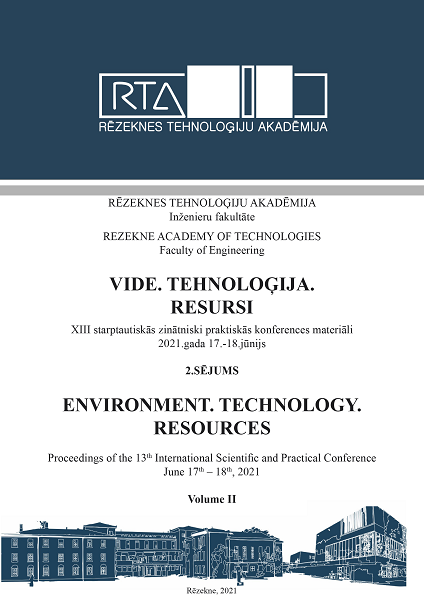STRUCTURAL MANAGEMENT PARADIGM IN THE MODELS OF NETWORK ORGANIZATIONS
DOI:
https://doi.org/10.17770/etr2021vol2.6631Keywords:
database, knowledge base, management paradigm, modelling, network organizationAbstract
Development problem of network organizations’ modelling methods is considered in this article. It is characterized with two fundamental directions that are the basis of the scientific approach. The authors offer one more aspect of modelling – taking into account the influence on the object’s structure and the produced products of external messages that carry structural rules, i. e. the rules needed for similar objects modelling.
References
V. N. Vasiliev, University management models based on information technologies. Petrozavodsk: Petrozavodsk State University, 2000. (in Russian)
A. I. Yudov, “Modelling the structure of technical means of the educational process based on the concept of network organization,” Proceedings of SPIIRAS, vol. 3, No. 1, pp. 206-210, 2002. (in Russian)
A. A. Samarsky, Introduction to the theory of differential schemes. Moscow: Nauka, 1971. (in Russian)
N. N. Krasovsky, Theory of motion control. Moscow: Nauka, 1968. (in Russian)
N. N. Moiseev, Mathematical tasks of system analysis. Moscow: Nauka, 1981. (in Russian)
V. V. Ivanishchev, “Modeling without an intermediary,” Izvestiya of the Russian Academy of Sciences. Theory and control systems, No. 5, pp. 27-32, 1997. (in Russian)
D. A. Pospelov, Situational management: theory and practice. Moscow: Nauka, 1986. (in Russian)
P. F. Drucker, Management Challenges for the 21st Century. New York: Harperbusiness, 1999.
M. S. Charles, 5th generation management: integrating enterprises through human networking. [Bedford, Mass.]: Digital press, 1990.
A. A. Erofeev and A. O. Polyakov, Intellectual control systems. St. Petersburg: SPbSTU, 1999. (in Russian)
A. O. Polyakov, “System paradigm of control,” Proceedings of St. Petersburg State Technical University: Computing, Automation, Radioelectronics, No. 472, pp. 32-49, 1998. (in Russian)
I. Antonov, I. Bruttan, D. Andreev, and L. Motaylenko, “The method of automated building of domain ontology,” in Environment. Technology. Resources: Proceedings of the 12th International Scientific and Practical Conference on Information Technologies, Rezekne, 2019, vol. II, pp. 34-37.
D. Andreev, S. Lyokhin, L. Motaylenko, and S. Verteshev, “Models and algorithms for constructing a formalized description of production technologies,” in Environment. Technology. Resources: Proceedings of the 12th International Scientific and Practical Conference on Information Technologies, Rezekne, 2019, vol. II, pp. 21-27.
G. S. Pospelov and D. A. Pospelov, Influence of methods of the theory of artificial intelligence on the solution of traditional control problems. Moscow: Scientific Council on the complex problem "Cybernetics", 1977. (in Russian)
D. Andreev, S. Lyokhin, V. Nikolaev, and O. Poletaeva, “Development of software for design ontological representations of production technologies,” in Environment. Technology. Resources: Proceedings of the 12th International Scientific and Practical Conference on Information Technologies, Rezekne, 2019, vol. II, pp. 28-33.
V. M. Lachinov and A. O. Polyakov, Informodynamics or the Path to the World of Open Systems. St. Petersburg: SPbSTU, 1999. (in Russian)
R. Penrose, Shadows of the Mind. New York: Oxford University Press Inc., 1999.
V. M. Nazaretov and D. P. Kim, Technical imitation of intelligence. Moscow: Higher School, 1986. (in Russian)
G. A. Bulkin and A. O. Polyakov, Automated information-logical system in the language of predicates. In the book: “Dialogue and factual systems”. Moscow: Nedra, 1979. (in Russian)
R. M. Yusupov et al., Telemedicine. New information technologies on the threshold of the XXI century. St. Petersburg: SPIIRAS, 1998. (in Russian)
Reports of the scientific session MIFI-2000. Volume 3. Data banks, intelligent systems, MIFI, 2000. (in Russian)
S. Verteshev, V. Konevtsov, “Processes control with fuzzy initial information in a complex of software design of digital control systems,” in Environment. Technology. Resources: Proceedings of the 11th International Scientific and Practical Conference on Engineering sciences and production technologies, Rezekne, 2017, vol. III, pp. 332-336.
S. Verteshev, V. Konevtsov, “Direct digital control in a complex of software design of digital control systems,” in Environment. Technology. Resources: Proceedings of the 11th International Scientific and Practical Conference on Engineering sciences and production technologies, Rezekne, 2017, vol. III, pp. 337-342.
K. Boulding, “General systems theory - the skeleton of science,” Studies in general systems theory, Moscow, 1969, pp. 106-124. (in Russian)
C. Shapiro and H. R. Varian, Information Rules: A Strategic Guide to the Network Economy. Boston: Harvard Business School Press, 1998.
V. Konevtsov, I. Poletaev, S. Verteshev, “Discrete automatic schemes for ASC TP,” in Environment. Technology. Resources: Proceedings of the 10th International Scientific and Practical Conference on Engineering sciences and production technologies, Rezekne, 2015, vol. I, pp. 67-71.
J. van Guig, Applied general theory of systems. Moscow: Mir, 1981. (in Russian)
A. I. Yudov, Organization of software and hardware of the university educational process. St. Petersburg: SPbSTU, 2002. (in Russian)



